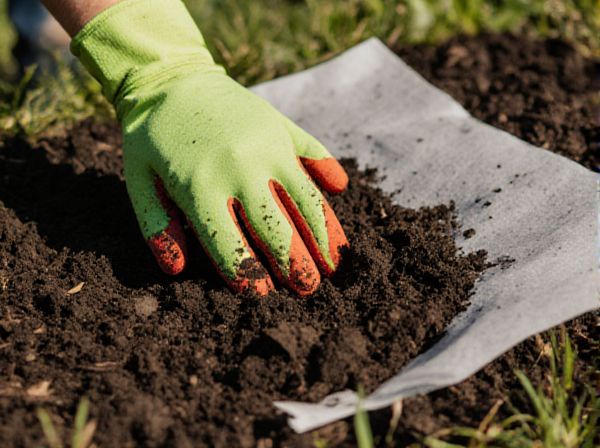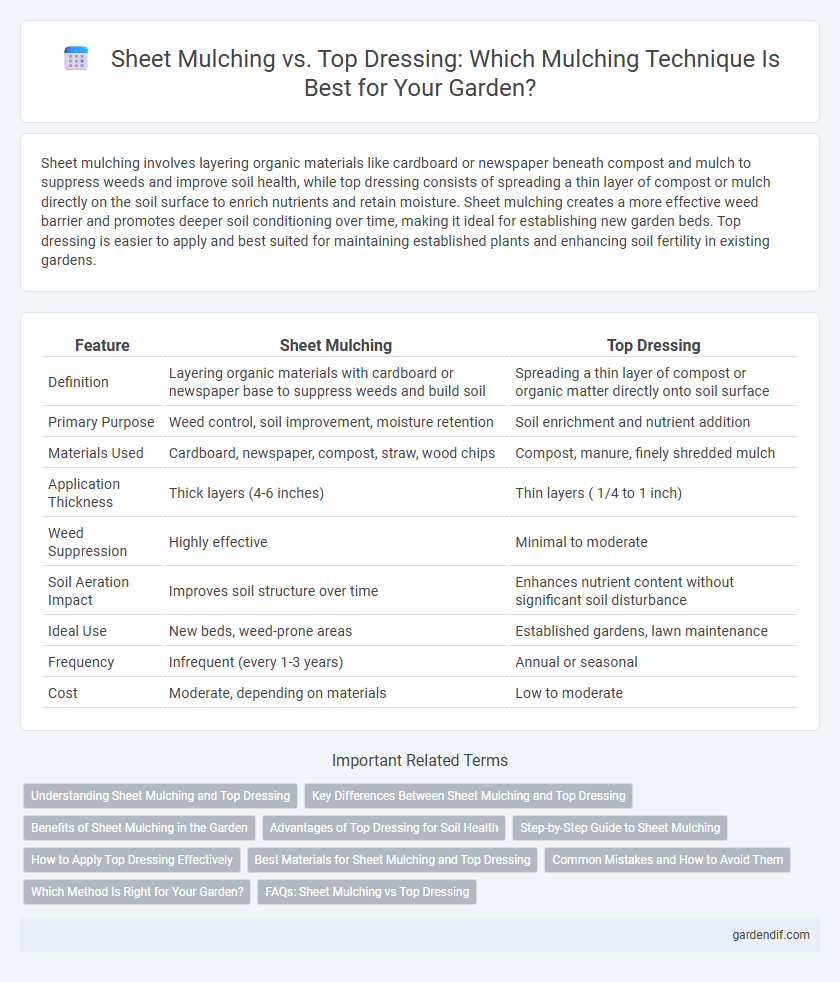
Sheet mulching vs top dressing Illustration
Sheet mulching involves layering organic materials like cardboard or newspaper beneath compost and mulch to suppress weeds and improve soil health, while top dressing consists of spreading a thin layer of compost or mulch directly on the soil surface to enrich nutrients and retain moisture. Sheet mulching creates a more effective weed barrier and promotes deeper soil conditioning over time, making it ideal for establishing new garden beds. Top dressing is easier to apply and best suited for maintaining established plants and enhancing soil fertility in existing gardens.
Table of Comparison
| Feature | Sheet Mulching | Top Dressing |
|---|---|---|
| Definition | Layering organic materials with cardboard or newspaper base to suppress weeds and build soil | Spreading a thin layer of compost or organic matter directly onto soil surface |
| Primary Purpose | Weed control, soil improvement, moisture retention | Soil enrichment and nutrient addition |
| Materials Used | Cardboard, newspaper, compost, straw, wood chips | Compost, manure, finely shredded mulch |
| Application Thickness | Thick layers (4-6 inches) | Thin layers ( 1/4 to 1 inch) |
| Weed Suppression | Highly effective | Minimal to moderate |
| Soil Aeration Impact | Improves soil structure over time | Enhances nutrient content without significant soil disturbance |
| Ideal Use | New beds, weed-prone areas | Established gardens, lawn maintenance |
| Frequency | Infrequent (every 1-3 years) | Annual or seasonal |
| Cost | Moderate, depending on materials | Low to moderate |
Understanding Sheet Mulching and Top Dressing
Sheet mulching involves layering organic materials such as cardboard, compost, and mulch directly onto soil to suppress weeds, retain moisture, and improve soil structure over time. Top dressing consists of applying a thin layer of compost or mulch on the soil surface to enhance nutrient content and promote healthy plant growth without disturbing existing soil layers. Both methods improve soil health but differ in application depth and long-term impact on soil ecology.
Key Differences Between Sheet Mulching and Top Dressing
Sheet mulching involves layering organic materials such as cardboard, compost, and mulch directly on garden beds to suppress weeds and improve soil fertility, while top dressing consists of applying a thin layer of compost or soil amendment over existing soil without layering. Unlike top dressing, sheet mulching creates a barrier that retains moisture and promotes microbial activity by decomposing layered materials over time. Sheet mulching is more labor-intensive and used for garden bed renovation, whereas top dressing is simpler and typically used for maintaining soil health and nutrient replenishment.
Benefits of Sheet Mulching in the Garden
Sheet mulching enhances soil health by layering organic materials that suppress weeds, retain moisture, and improve nutrient content over time. This method promotes beneficial microbial activity and reduces soil erosion more effectively than top dressing. The process builds rich, fertile soil naturally, supporting stronger plant growth and increased garden productivity.
Advantages of Top Dressing for Soil Health
Top dressing enriches soil health by gradually releasing nutrients, improving microbial activity, and enhancing soil structure without disturbing plant roots. This method promotes better moisture retention and reduces soil erosion, supporting sustainable garden ecosystems. Unlike sheet mulching, top dressing allows for easier nutrient absorption and faster breakthrough of organic matter into the soil profile.
Step-by-Step Guide to Sheet Mulching
Sheet mulching involves layering cardboard or newspaper directly on soil, followed by organic materials like compost and mulch to suppress weeds and enrich soil health. Start by mowing existing vegetation, then lay down overlapping sheets of cardboard, water thoroughly to speed decomposition, and add a 3-6 inch layer of compost followed by a thick mulch layer such as wood chips or straw. This method improves soil structure, retains moisture, and promotes beneficial microbial activity more effectively than top dressing, which only adds materials on the surface without breaking down underlying weeds or compacted soil.
How to Apply Top Dressing Effectively
Apply top dressing by evenly spreading a thin layer of organic material such as compost or well-aged manure over the soil surface, ensuring it covers the root zone without smothering plants. Water the area thoroughly after application to help nutrients penetrate the soil and activate microbial activity. Repeat the process annually or as needed to maintain soil fertility and enhance plant growth effectively.
Best Materials for Sheet Mulching and Top Dressing
Sheet mulching thrives with materials like cardboard, newspaper, and composted manure, which suppress weeds and enrich soil nutrients effectively. Top dressing benefits most from fine, nutrient-rich compost, well-aged leaf mold, or balanced organic fertilizers to enhance soil surface health and promote microbial activity. Selecting high-quality, decomposable organic matter ensures optimal moisture retention and nutrient release in both methods.
Common Mistakes and How to Avoid Them
Sheet mulching often leads to overly thick layers that prevent water penetration, while top dressing can be applied too thinly, reducing its effectiveness in moisture retention and weed suppression. Common mistakes include failing to properly prepare the soil before sheet mulching, such as not removing weeds or compacted soil, and using inappropriate materials that hinder decomposition. To avoid these issues, ensure a balanced layering of organic matter in sheet mulching and consistently apply top dressing at recommended thicknesses, monitoring soil moisture to optimize plant health.
Which Method Is Right for Your Garden?
Sheet mulching creates a weed-suppressing, nutrient-rich barrier by layering organic materials directly on soil, making it ideal for establishing new garden beds or revitalizing poor soil. Top dressing involves spreading a thin layer of compost or mulch over existing soil, which enhances soil fertility and moisture retention without disturbing plant roots, suitable for established gardens. Choosing between these methods depends on your garden's current condition: opt for sheet mulching to rebuild soil structure or top dressing to maintain and nourish healthy soil.
FAQs: Sheet Mulching vs Top Dressing
Sheet mulching involves layering cardboard or newspaper with compost and organic materials to build soil health and suppress weeds effectively, while top dressing primarily adds a thin layer of compost or mulch over the soil surface to improve nutrient content and moisture retention. Frequently asked questions highlight that sheet mulching is better for weed control and long-term soil improvement, whereas top dressing is often preferred for quick nutrient boosts and aesthetic enhancement. Gardeners choose sheet mulching for sustainable soil transformation and top dressing for regular maintenance and immediate benefits.
Sheet mulching vs top dressing Infographic

 gardendif.com
gardendif.com